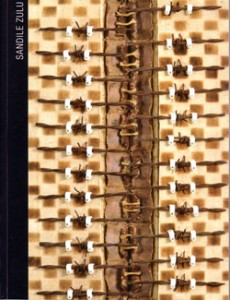Sandile Zulu has, over the last decade, developed a working method that relies as much on rhythm and repetition as it does on the unpredictability of the elements – fire, water, found objects – he uses.
He is, as Colin Richards notes in his meticulously researched essay, a pyromancer, a collector of natural elements, and a scavenger after industrial debris. Zulu’s wide-ranging interests in science, astronomy, and pan-African philosophy, and his innovative use of fire have resulted in a body of work that stands up to rigorous interpretation but conveys a profound appreciation of patterns and harmony.
Important pieces such as Royal Court Art Work and his”Artomic Passages”series, attest to a meditative aesthetic philosophy, a disciplined artistic practice, and a keen awareness of the often-difficult relationship between art and society. Sandile Zulu has participated in numerous group exhibitions both locally and abroad, and his work is in many private and public South African collections.
In July 2005 he mounted his first international solo show in London.
Colin Richards has published widely on South African art and curated several major exhibitions. He lectures in art criticism, studio practice, and art theory at the Wits School of Arts, and is a practising artist whose work is included in most major South African public collections.
Philippa Hobbs is the author for the educational supplement published with TAXI-012 Sandile Zulu.
EXTRACT FROM THE BOOK
Burn! : Portrait of a Young Artist as Firebrand
I: Starting Out
Sandile Zulu uses natural energies and everyday, organic materials to create his artworks. Fire, wind, water, earth, the skins of animals, seeds, roots, grass, glue, cardboard, paper, canvas. But his is not a pure nature. Zulu also scavenges urban waste, recycling barbed wire, glass beads, plastic, string, rope, industrial moulds, metal, sponge rubber and metropolitan debris of every kind. His art is as much a synthesising collateral creativity of a decaying urbanism as it is of rural nature. The aesthetic tone is ritualistic and repetitive, mantric and mesmerising
His creative method – if we can trap what he does in a ‘method’ – is mostly additive and cumulative. In many works, simple, primary units and marks systematically mutate and multiply, creating intricate, iconic wholes. Elementary aesthetic ‘atoms’ evolve into building blocks for elaborate image fields in, for example, Camouflage 1 (1998), Indluyengwe Yokuqala (Leopard’s Lair 1) (2000) and the aptly named Elementary Units and Relationships 1 and 2 (2003). Zulu’s creative practice is patterned on natural processes involving constancy and change. Such patterning is also part of our man-made, urban habitats, something to which he is also sensitive. Not for nothing was his father a builder and his mother a designer of clothes. Both supported their son’s creativity in every way.
II: The Studio (Inside)
Sandile Zulu is a pyromancer. His work is a wellspring for ever-expanding social meanings and aesthetic energies. This much is clear if you have the good fortune of visiting his studio in downtown Fordsburg. There, you will enjoy an unrivalled vision of his remarkable creative cosmos. Set out on the industrial floor, itself a scuffed and scarred landscape as if seen from high above, a loose, grid-like encyclopaedia of objects and materials is arranged in an oddly ‘haphazard’ order.
A long line of short, single cut lengths of blackened barbed wire rests next to the same wire carefully bundled and bound with white string. These barbed bouquets look like beheaded roses and appear in Study for Abduction (1997) and Abduction (1997). The short, carefully arranged single lengths of wire recall amongst other things the patterns on ‘traditional’ Zulu battle shields as well as the ribbed fronts of British dress-tunics of the nineteenth-century colonial military. The violent conflict enjoined in these works finds wider expression in the Dachau installation, which included Procession of Stones (2004) and Procession of Ambers 1 and 2 (2004).
Some surpassingly strange and beautiful things include the rusted upper rim of a paint-tin, with the once-liquid contents forming a petrified ring of drips, like solid fire. Inside the rust-tinged ring of hardened fluid, a cut-off coconut shell nestles. The wiry fibres of the coconut shell have been patiently separated and knotted as one might hair, pointing to the importance of body-dressing in our culture and to our tendency to anthropomorphise natural, non-human phenomena, including fire, so central to Zulu’s creative project. Stephen Pyne writes “it is testimony to the immense significance of fire that humanity has for so long chosen not only to anthropomorphise it but to grant it a substantive identity it does not deserve.†The traces of fire are evident everywhere; singed foam rubber, pieces of cold lava from the Island of Réunion, a sinister, fleshy, fire-scarred growth from a gum tree. Two exquisite sunflower heads – one dimmed and dried by sun and fire – tell of the regularity and constancy of nature, but also its violence and indifference.
DETAILS OF BOOK
Soft-cover, 20×25 cm, 127 Pages
Author: Colin Richards
ISBN: 0 958 4688 7 7
© The authors, the artist, and David Krut Publishing, 2005
ENQUIRIES
TAXI-012: Sandile Zul, available through David Krut Publishing

